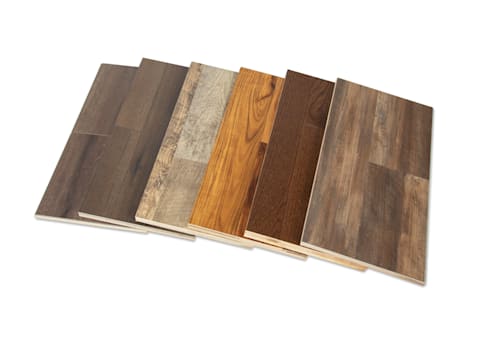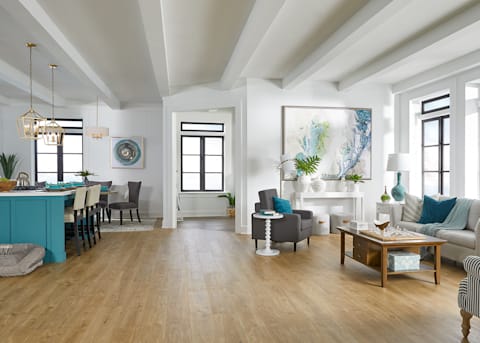- Home
- Education
- Flooring Basics
- Vinyl Vs. Hardwood: What's the Difference?
Vinyl Vs. Hardwood: What's the Difference?
Want to know the connection between hardwood floor versus engineered wood floor versus vinyl? Know their characteristics, styles, and benefits with LL Flooring.
Deciding on the best flooring for your space is a process with several options to consider. The flooring industry is constantly evolving, and many flooring types and styles have distinct features. It can be tough to decide not just on the style but on things like finishes, wear layers, and installation methods. Understanding the similarities and differences between products like vinyl and hardwood will lead to informed decisions about which type of flooring will work best for your project.
What Is Vinyl?
Vinyl flooring is a wear-resistant and waterproof flooring product that offers value. Usually, it consists of four layers of material:
- Wear layer: This top layer protects the others and adds texture.
- Design layer: This high-resolution printed layer gives the flooring its colors and designs.
- Waterproof layer: The waterproof layer protects vinyl flooring from moisture. It’s constructed from either wood-plastic or stone-polymer composite (SPC).
- Backing layer: The bottom of vinyl flooring works as an underlayment and provides comfort and support. It’s usually made from foam or caulk.
LL Flooring offers rigid vinyl plank (RVP) and luxury vinyl plank (LVP) flooring. RVP has an SPC core that adds toughness for supporting weight like heavy furniture. It also helps support the floor’s stability through seasonal temperature changes and exposure to direct sunlight. LVP offers a cost-effective solution with many of the benefits of RVP.
Installation
Vinyl flooring is known for its ease of installation. Whether you’re a weekend DIYer or a professional installer, you’ll find installation types suited to your experience level. These include glue-down, click-lock, and peel-and-stick installation methods. The Warranty, Installation, and Care (WIC) guide will be a valuable resource in this process.
Design
Best of all, the pattern print layer of vinyl flooring means there is an extensive selection of styles and colors for you to choose from. This means you get to express your personality in your design or mix and match to fit any décor. At LL Flooring, our designs include detailed wood-look and stone-look products that accurately mimic natural materials.
Maintenance
It’s easy to care for vinyl flooring. You can use a broom, combination sweeper-mop, or vacuum to keep it clean. And, because it’s waterproof, you can use wet mops or steam mops set to the appropriate setting. For best results, use cleaning products designed for vinyl flooring.
Vinyl is also quiet underfoot. The attached underlayment, as well as properly prepared subfloors, also help to provide added sound insulation for both vinyl and hardwood floors.
What Is Hardwood?
Hardwood is of course the prestige flooring option, and has been for decades. It's crafted using real wood, which gives a natural feel full of character. With hardwood flooring, you can experience the beauty of nature combined with endurance, warmth, and longevity. When choosing wood flooring, you’ll have the option of either solid hardwood or engineered hardwood. Both showcase the appeal of natural wood and have their own distinct benefits.
Solid Hardwood
Hardwood is a natural flooring that brings character, life, and value to your room. With solid hardwood, each board is unique—with no pattern repeats—because every tree has its own lines, knots, and whorls. Solid hardwood is also receptive to various finishes, stains, and textures, making it a versatile backdrop to your interior design.
For many, the luxury of solid hardwood is difficult to resist. It’s always been a staple of the flooring industry and continues to bring life and elegance to many homes.
Engineered Hardwood
Engineered hardwood has the benefits of natural wood combined with increased performance from an engineered core. This product is covered with a top layer, or veneer, of natural hardwood. Beneath this is the engineered core that adds strength to the flooring.
One of the benefits of engineered hardwood is that it allows for varied lengths and widths of the boards. It comes with different installation methods, depending on the product, and can be installed on all levels of your home—including basements.
Solid Hardwood Vs. Engineered Hardwood
It’s tough to choose between solid and engineered hardwood. Both flooring products come in a wide selection of species, colors, and finishes. The natural patterns in the wood aren’t replicated, ensuring your floor is unique.
The difference is that solid hardwood is made from one continuous piece of wood, while engineered hardwood is made of a veneer of wood attached to a core. This layered construction makes engineered hardwood a more dimensionally-stable product.
Solid hardwood flooring is ideal for floors on grade or one level above grade, such as the ground and first floors. Installing solid hardwood below grade, such as basements, is not recommended as the moisture is often too high. Engineered hardwood is suitable for installation below, at, or above grade.
At LL Flooring, our solid hardwoods can come with nail, staple, and glue-down installation methods. Nail and staple methods are relatively straightforward. This makes them more cost-effective, whereas glue-down installation takes longer. Engineered hardwood is tongue and groove profile or click-lock installation. With proper subfloor preparation, you can DIY both types of hardwood flooring, but if you prefer, you can use professional independent contractors instead. If you choose the DIY method, be sure to consult the WIC guide for your flooring.
Vinyl Plank Flooring Vs. Hardwood
Vinyl flooring offers many of the benefits of hardwood. It’s a versatile flooring product with the added benefit of being waterproof. Below are some characteristics of each type of flooring to compare and contrast their qualities.
Appearance
Both vinyl and hardwood flooring offer a wide selection of colors and styles. Wood brings natural character and is a natural product so there are no repeated patterns, while vinyl gives you easy access to a comprehensive selection of designs.
Resilience
Hardwood has a natural toughness that stands up well to everyday living. The SPC core in some engineered hardwood makes it exceptionally resilient.
Vinyl is waterproof, which makes it great for any area of the home, especially wet rooms like bathrooms and laundry areas.
Maintenance
Vinyl flooring is one of the easiest to maintain. Its tough surface means that you can use a variety of cleaning products and tools—even steam mops when set to the right setting. Hardwood flooring is also easy to maintain, but you’ll want to turn off your vacuum’s beater bars and avoid vacuums with stiff bristled rollers, string mops, and other tools that use a lot of water or steam.
LL Flooring recommends using flooring-specific cleaning supplies with vinyl and hardwood for best results. With hardwood floors, you’ll want a more natural and gentler product to help maintain its natural shine. For vinyl flooring, harsh chemicals can dull its sheen. Also, we recommend becoming familiar with the WIC guide associated with any wood flooring product you purchase from LL Flooring.
Cost
Generally, vinyl is more cost-effective, but this depends on several factors. One aspect to consider is the installation type and the associated costs. Peel-and-stick is one of the more affordable installation methods, while nail-down boards can cost more in terms of labor.
Installation
Vinyl flooring generally has more variety in the installation methods you’ll find. Depending on the product, your vinyl could use glue-down, float-and-click, or peel-and-stick installation. Hardwood is more likely to use glue, nail, or staples, but can also use float-and-click. While hardwood used to be more difficult to install than vinyl in the past, with precut boards and tongue-and-groove profile options available, experienced DIYers can get it done.
What Is Better: Vinyl or Hardwood Flooring?
As production methods evolve, the difference between vinyl and hardwood is more challenging to spot. Users once distinguished based on how the boards felt underfoot, but even that is changing as new subflooring and underlayment come on the market. You may also want to consider your return on investment, for which hardwood flooring comes out on top. While vinyl requires less upfront investment, it is also less durable and has less long-term value.
The better flooring choice comes down to your needs and the scope of your project. Once you’ve compared the features of each, decide on your budget, where you're installing, and which style best fits your décor. That’s when you’ll know whether vinyl or hardwood is better for your project.
Finding Your Flooring
Deciding between vinyl and hardwood flooring depends on the use and design of the rooms it’s meant for. Think about elements like foot traffic, moisture, and more. As you browse our flooring options and compare their features, try LL Flooring’s Picture It! Floor Visualizer to compare what our vinyl or hardwood options would look like in your home. Or you can order from our selection of sample kits for a more tangible sampling. Using these tools to visualize your flooring options in your home will help you make more informed decisions about the best flooring option to meet your needs. You can also visit our stores to chat more with our knowledgeable flooring experts.

Follow LL Style on Instagram & Pinterest
ALSO, do you learn about home improvement and design with fun and informative videos? Subscribe to the LL Flooring YouTube Channel to learn more, leave comments or ideas that helped you, and join the community!





